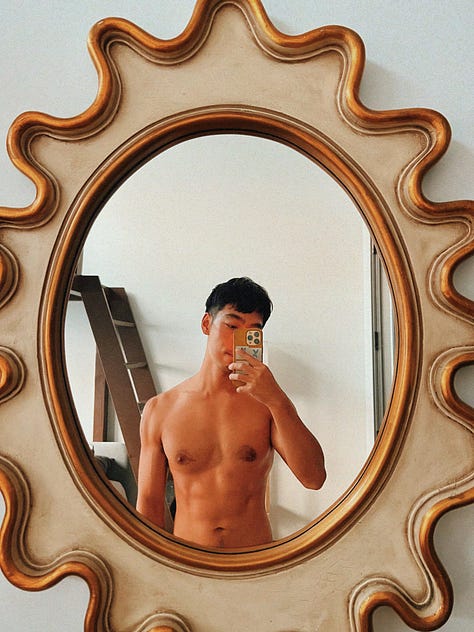Resisting Western Beauty Standards with the World’s Biggest Rodent
The capybara is my digital therapist.
Hello capybaras! Thanks for reading Sleepover. In the spirit of accessibility, this newsletter will always be offered for free. Please consider a paid subscription if you’d like to support the things I create — with and beyond this project.
I am obsessed with capybaras. A few years ago, prior to the rest of the world’s craze (“I found them first!” he yells out, as no one cares), I found the animal on Instagram and was captivated by its cute appearance, sociable personality, and general ethos: Every capybara I saw was unbothered, sitting in a hot tub, befriending a crocodile, or squatting with a tangerine on its head. I began to go out of my way to consume capybara content and tell Instagram that I was not interested in the other genres of posts that so often cluttered my newsfeed, primarily photos of ripped, shirtless men of some European descent: strong jawlines, zero body fat, masculine features, and thoughtless captions. By holding my thumb on each of these men, clicking “Not interested,” and intentionally liking every capybara post I saw, my Discovery feed, over time, became an altar to the animal.
The desire to see less half-naked, Eurocentric models on Instagram is a desire I have felt for a while now, and attempting to curate my algorithm into something I choose as opposed to something that reflects what my subconscious pays most attention to has become a yearly routine. Before I discovered capybaras, I remapped my Discovery feed to showcase photos of small pigs, golden retrievers, and queer-related content. But, like many, my eyes drift to and linger on strong, shirtless men, especially when presented with them in moments of unintentional scrolling, so it is almost unavoidable that my Discovery feed reverts back to being an altar to them. When I find myself in the trenches of pecs and abs, I restart the process.
Attempting to curate my own algorithm is a mild form of resistance against the beauty standards that I have been questioning ever since I became aware of their presence in my life. When I was younger, the only men I saw on screen looked like Chris Evans, and even recent studies demonstrate that — despite increasing awareness — the representation of queer, BIPOC+, and womxn individuals in media remains disproportionately low compared to the population. From an early age, we are taught to picture life through a White, male lens. We learn that the hero is fair, chiseled, and masculine, and the heroine slim and petite. Unsurprisingly, I wanted these things throughout my adolescence and youth, and punished myself for not embodying them. But why?


Asking myself this question, and challenging the way that I perceive what is beautiful or what is good, is important to me, for by doing so I can become an active contributor to the perceptions that shape my beliefs, preferences, and relationships, with others and myself. While I do not see it as a problem to be attracted to Whiteness, Western features, or traditional displays of masculinity, I also do not see it as a choice. And that, in and of itself, is limiting.
Curating my algorithm is also a form of self-preservation against the harm that beauty standards have the power to inflict. Frequent social media use has been linked to the explosive rise in eating disorders, which are often exacerbated by intersections of racial, sexual, and gender-based stigmatization. In a world where Instagram models remove their ribs with photoshop and well-intentioned trends, like girl dinner, are misused to gloat caloric deficits, choosing to see less of the kinds of bodies and faces I have compared myself to since childhood is a way of supporting the appreciative relationship I have developed with my own face and body, after struggling with body dysmorphia for years.



Making these choices, no matter how minor they are, is freeing, and the process of deconstruction itself is inherent to my queerness. To claim a queer identity is to make an active choice to not live the way that society teaches us to. After making that choice, I began to re-examine why I chose to attempt to live a life that did not suit me for so many years (lack of representation, fear of othering, inability to question), and soon it became second-nature to examine what other areas of my life I was still adhering to, as opposed to actively choosing.
It is exciting to approach life with a thoughtful wrench and begin disassembling its constructs, for it means that I am beginning to build something for myself. Once we start deconstructing the narratives we’ve lived with for years — narratives that explicitly or subtly convince us that certain things are good, better, or beautiful, most often times things we are not — then we may begin constructing our own narratives to encompass the things we identify with, believe in, and choose at this moment in time.
Hence: My feed full of capybaras, who defy beauty standards of their own, winning admirers from around the globe despite being the world’s largest rodent, a class of animals often characterized as the ugliest and the dirtiest of mammals. They graze the low, green fields in Brazil, befriend pelicans, cats, and horses, and wade around pools of steaming water in a meditative stance, embodying a phrase I did not have the language for in the first act of my life:
I am enough.



Capy Corner: The Xanax of News 🙂
For once, some good news — helping us be a little less stressy and depressy! Here’s a roundup of some wins in cultural diversity and representation for queer, BIPOC+, and womxn-identifying communities around the globe:
Mexico’s Supreme Court decriminalizes abortion nationwide - nyt
Mexico's Supreme Court has decriminalized abortion nationwide, overturning a federal penal code that labeled the procedure "unconstitutional," thereby permitting abortions in all federal health institutions. The decision, a significant step in a predominantly Catholic country, comes amid a wave of Latin American nations expanding abortion rights.
California becomes the first state to declare a Transgender History Month - them
California's State Assembly approved House Resolution 57, designating August as Transgender History Month from 2024 onwards, making California the first state to do so. The resolution highlights California's crucial role in trans history, and was led by Jupiter Peraza and The Transgender District’s ongoing advocacy efforts.
Ava DuVernay makes history at the Venice Film Festival after being told, 'Don't apply. You won't get in' - la times
Ava DuVernay became the first African American woman to direct a feature in competition at the Venice Film Festival, premiering her film "Origin." During the event, DuVernay highlighted the challenges Black filmmakers face in the international festival circuit, recalling discouragement from applying to Venice and emphasizing the importance of independent filmmaking over major studios, which often dictate casting choices based on perceived market value.
Women in journalism pass another milestone with Kristen Welker as the 13th moderator of "Meet the Press" - washington post
Kristen Welker will become the 13th moderator of "Meet the Press," marking a milestone where every major Sunday public affairs program will have a female moderator or co-moderator. Pioneers like Welker, who will be the first Black person and the second woman to host the show since its inception in 1947, signal a hopeful shift toward equal representation in journalism.
Coco Gauff wins the U.S. Open, becoming the first teenager to do so since Serena Williams in 1999 - nyt
Coco Gauff won her first Grand Slam title at the U.S. Open, with her victory heralding an influx of endorsement opportunities, increased fame, and expectations. Despite the attention, Gauff remains composed, attributing her groundedness to her father's influence and her own early introduction to the limelight, while her coach, Pere Riba, emphasizes her strong work ethic and predicts further growth in her career.
Playlist of the Week: 10 Songs for Vibing Like a Capybara 🎛️
This week’s playlist features foodman (an artist dabbling in experimental electronics from Nagoya, Japan), Andruss (a Mexican DJ and producer who is garnering international attention), and the famous Jayda G (a Grammy-nominated house icon, who I’ve been obsessed with for years).
Thanks for reading the Sleepover newsletter!
Your feedback is always appreciated. Reply to this email or comment on the Substack post to let me know what you liked, what you didn’t like, and what you want to see more of.
With love,
Your favorite capybara ~ AKA Travis Zane
Follow me on: Instagram 🪩 TikTok 🪩 Twitter 🪩 YouTube 🪩 Twitch 🪩 Website
Follow Sleepover on: YouTube 🪩 Instagram 🪩 TikTok 🪩 Twitter
Sleepover is a party that turns into a sleepover, a newsletter publishing cozy content to your inbox every week, and an occasional mixed media series promoting BIPOC+, queer, and womxn-identifying creators — produced online and in print.





☺️